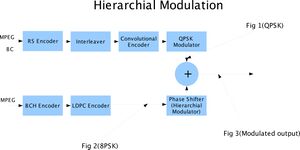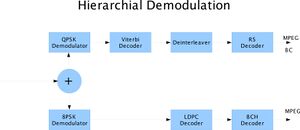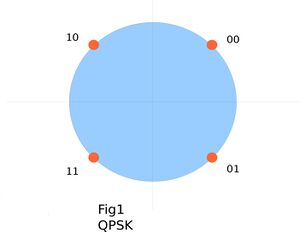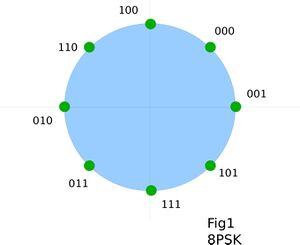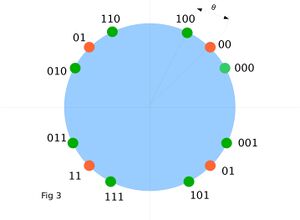DVB-S2: Difference between revisions
m (→Backward compatibility: fix typo - missing "i") |
|||
| (15 intermediate revisions by 9 users not shown) | |||
| Line 5: | Line 5: | ||
* four modulation modes: QPSK, 8PSK, 16APSK and 32APSK |
* four modulation modes: QPSK, 8PSK, 16APSK and 32APSK |
||
* forward error correction algorithms: BCH and LDPC |
* forward error correction algorithms: BCH and LDPC |
||
* content is not limited to [[ |
* content is not limited to [[MPEG-2 Transport Stream]] anymore |
||
* multiple streams |
* multiple streams |
||
* physical layer scrambling (improves data integrity) |
* physical layer scrambling (improves data integrity) |
||
| Line 14: | Line 14: | ||
DVB-S2 is a newer specification of the [[DVB-S]] standard with better performance and intended for professional users too. Due to its flexibility it has become the preferred way for transmission of [[HDTV]] content. |
DVB-S2 is a newer specification of the [[DVB-S]] standard with better performance and intended for professional users too. Due to its flexibility it has become the preferred way for transmission of [[HDTV]] content. |
||
DVB-S2 was developed by the DVB (Digital Video Broadcasting) Project in 2003. It benefits from better error correction algorithms (BCH and LDPC) combined with a variety of modulatios (QPSK, 8PSK, 16APSK and 32APSK) and a powerful stream handling. |
DVB-S2 was developed by the DVB (Digital Video Broadcasting) Project in 2003. It benefits from better error correction algorithms (BCH and LDPC) combined with a variety of modulatios ([[Quadrature_Phase_Shift_Keying|QPSK]], 8PSK, 16APSK and 32APSK) and a powerful stream handling. |
||
Backward compatible modes are available which allow using existing DVB-S devices as well as broadcasting additional content for DVB-S2 capable devices during |
Backward compatible modes are available which allow using existing DVB-S devices as well as broadcasting additional content for DVB-S2 capable devices during transition periods. |
||
Four modulation modes can be selected for transmission. While QPSK and 8PSK are typically used for broadcast services, there are modes for professional applications too. 16APSK and 32APSK allow higher bandwidth but require higher signal quality. They are normally used in unicast environments where the receiver can feed back to the uplink station. In this case the uplink station can choose the best transmission method. |
Four modulation modes can be selected for transmission. While [[Quadrature_Phase_Shift_Keying|QPSK]] and 8PSK are typically used for broadcast services, there are modes for professional applications too. 16APSK and 32APSK allow higher bandwidth but require higher signal quality. They are normally used in unicast environments where the receiver can feed back to the uplink station. In this case the uplink station can choose the best transmission method. |
||
For broadcasters there are several reasons to use those new features of DVB-S2: |
For broadcasters there are several reasons to use those new features of DVB-S2: |
||
| Line 31: | Line 31: | ||
Therefore two backward compatible modes have been defined in DVB-S2. They support transmitting two streams at the same frequency (a non-DVB-S2 stream, called High Priority or HP stream, compatible with old receivers and a DVB-S2 stream, called Low Priority or LP stream, compatible with DVB-S2 receivers only). |
Therefore two backward compatible modes have been defined in DVB-S2. They support transmitting two streams at the same frequency (a non-DVB-S2 stream, called High Priority or HP stream, compatible with old receivers and a DVB-S2 stream, called Low Priority or LP stream, compatible with DVB-S2 receivers only). |
||
* Layered modulation: The HP stream is transmitted at a significantly higher power level than the LP stream. A non-DVB-S2 capable device only receives the HP stream (but with |
* Layered modulation: The HP stream is transmitted at a significantly higher power level than the LP stream. A non-DVB-S2 capable device only receives the HP stream (but with additional noise), whereas a DVB-S2 capable device receives the LP stream. This would require the launch of new designed satellites. Therefore it's not very likely that this mode will be used. |
||
* Hierarchical modulation: The HP stream and the LP stream are mapped together into a non-uniform 8PSK constellation. The resulting signal can be driven near saturation, so the performance loss is not very big at this mode. |
* Hierarchical modulation: The HP stream and the LP stream are mapped together into a non-uniform 8PSK constellation. The resulting signal can be driven near saturation, so the performance loss is not very big at this mode. |
||
[[Image:hmod.jpg]] |
[[Image:hmod.jpg|thumb|Hierarchical Modulation]] |
||
[[Image:hdmod.jpg]] |
[[Image:hdmod.jpg|thumb|Hierarchical Demodulation]] |
||
[[Image:qpsk.jpg]] |
[[Image:qpsk.jpg|thumb|QPSK]] |
||
[[Image:8psk.jpg]] |
[[Image:8psk.jpg|thumb|8PSK]] |
||
[[Image: |
[[Image:bcompat.jpg|thumb|bcompat]] |
||
==Details== |
==Details== |
||
The DVB-S2 system may be used in "single carrier per transponder" or in "multi-carriers per transponder" (FDM) configurations. In single carrier per transponder configurations, the transmission symbol rate Rs can be matched to given transponder bandwidth BW (at -3 dB), to achieve the maximum transmission capacity compatible with the acceptable signal degradation due to transponder bandwidth limitations. |
The DVB-S2 system may be used in "single carrier per transponder" or in "multi-carriers per transponder" (FDM) configurations. In single carrier per transponder configurations, the transmission symbol rate Rs can be matched to given transponder bandwidth BW (at -3 dB), to achieve the maximum transmission capacity compatible with the acceptable signal degradation due to transponder bandwidth limitations. |
||
The DVB-S2 system may also deliver broadcasting services over multiple Transport Streams, providing differentiated error protection per multiplex (VCM). A typical application is broadcasting of a highly protected multiplex for SDTV, and of a less protected multiplex for HDTV. Assuming we transmit a symbol rate of 27.5 Mbaud and use 8PSK 3/4 and QPSK 2/3 modulation, 40 Mbit/s could be available for two HDTV programmes and 12 Mbit/s for two to three SDTV programmes, with a difference in C/N requirements of around 5 dB. |
The DVB-S2 system may also deliver broadcasting services over multiple Transport Streams, providing differentiated error protection per multiplex (VCM). A typical application is broadcasting of a highly protected multiplex for SDTV, and of a less protected multiplex for HDTV. Assuming we transmit a symbol rate of 27.5 Mbaud and use 8PSK 3/4 and [[Quadrature_Phase_Shift_Keying|QPSK]] 2/3 modulation, 40 Mbit/s could be available for two HDTV programmes and 12 Mbit/s for two to three SDTV programmes, with a difference in C/N requirements of around 5 dB. |
||
The DVB-S2 system may deliver broadcasting services over multiple Transport Streams, providing differentiated error protection per multiplex (VCM mode) |
The DVB-S2 system may deliver broadcasting services over multiple Transport Streams, providing differentiated error protection per multiplex (VCM mode) |
||
| Line 67: | Line 67: | ||
==Hardware== |
==Hardware== |
||
See [[DVB-S2 Devices]] |
|||
currently none supported. |
|||
There are couple of DVB-S2 based cards and a few frontends too |
|||
The frontend chips that are available are |
|||
# STB0899 + STB6100 |
|||
# Broadcom 4500 |
|||
# Conexant |
|||
The cards that do have them are: |
|||
{| |
|||
| KNC1 <sup>1</sup> || STB0899 + STB6100 + SAA7146 (PCI32, supports CI) |
|||
|- |
|||
| Twinhan (VP-1041) <sup>2</sup> || STB0899 + STB6100 + Mantis |
|||
|- |
|||
| TT <sup>3</sup>|| STB0899 + STB6100 + SAA7146 (PCI32, not sure about CI support) |
|||
|- |
|||
| Genpix 8PSK module <sup>4</sup>|| Broadcom 4500 (USB) Couldn't see any S2 specifics in this one, so don't know whether it is S2 compliant |
|||
|- |
|||
| Micronas <sup>5</sup>|| STB0899 + STB6100 + Micronas PCI Bridge (Dual DVB-S2, PCIe, no CI) |
|||
|} |
|||
Only the genpix 8PSK module can be bought for now and they have a driver too (similar one to the dst module). The rest of the devices will be available soon in the market. |
|||
haven't heard much about the Conexant chip. |
|||
PS: The Linux DVB-S2 API itself is not yet ready. Work is in progress, Cards <sup>1</sup> and <sup>3</sup> will be the first supported cards, <sup>2</sup> and <sup>5</sup> needs some more work at the relevant PCI Bridge. Regarding <sup>4</sup> there are patches floating around. |
|||
[[Category:Technology]] |
[[Category:Technology]] |
||
[[Category:DVB]] |
|||
[[Category:DVB-S2]] |
|||
Latest revision as of 20:54, 1 February 2020
DVB-S2 stands for Digital Video Broadcasting via Satellite version 2.
It supports quite a lot of features:
- multiple rolloff factors: 0.20 and 0.25 in addition to 0.35 used for DVB-S (saves transmission power)
- four modulation modes: QPSK, 8PSK, 16APSK and 32APSK
- forward error correction algorithms: BCH and LDPC
- content is not limited to MPEG-2 Transport Stream anymore
- multiple streams
- physical layer scrambling (improves data integrity)
- adaptive modulation for optimal transmission bandwidth (used for professional applications)
General
DVB-S2 is a newer specification of the DVB-S standard with better performance and intended for professional users too. Due to its flexibility it has become the preferred way for transmission of HDTV content.
DVB-S2 was developed by the DVB (Digital Video Broadcasting) Project in 2003. It benefits from better error correction algorithms (BCH and LDPC) combined with a variety of modulatios (QPSK, 8PSK, 16APSK and 32APSK) and a powerful stream handling. Backward compatible modes are available which allow using existing DVB-S devices as well as broadcasting additional content for DVB-S2 capable devices during transition periods.
Four modulation modes can be selected for transmission. While QPSK and 8PSK are typically used for broadcast services, there are modes for professional applications too. 16APSK and 32APSK allow higher bandwidth but require higher signal quality. They are normally used in unicast environments where the receiver can feed back to the uplink station. In this case the uplink station can choose the best transmission method.
For broadcasters there are several reasons to use those new features of DVB-S2:
- increased data throughput for a given bandwidth
- increased availabilty because of improved error correction
- increased coverage area
Backward compatibility
A key factor is also the backward compatiblility: There is a large population of DVB-S receivers used in the world which must continue to service customers for several years without the need to purchase new device - especially if there is a receiver subsidy or if public services are broadcasted. So established broadcasters can't switch abruptly to DVB-S2 only.
In this case the backward compatiblility feature of DVB-S2 is very important: During the migration process it allows DVB-S devices to continue operating while it provides additional services to advanced receivers. At the end of the transition process, when most of the receivers are capable of DVB-S2, they can switch to the non-backward compatible mode and exploit the full potential of DVB-S2.
Therefore two backward compatible modes have been defined in DVB-S2. They support transmitting two streams at the same frequency (a non-DVB-S2 stream, called High Priority or HP stream, compatible with old receivers and a DVB-S2 stream, called Low Priority or LP stream, compatible with DVB-S2 receivers only).
- Layered modulation: The HP stream is transmitted at a significantly higher power level than the LP stream. A non-DVB-S2 capable device only receives the HP stream (but with additional noise), whereas a DVB-S2 capable device receives the LP stream. This would require the launch of new designed satellites. Therefore it's not very likely that this mode will be used.
- Hierarchical modulation: The HP stream and the LP stream are mapped together into a non-uniform 8PSK constellation. The resulting signal can be driven near saturation, so the performance loss is not very big at this mode.
Details
The DVB-S2 system may be used in "single carrier per transponder" or in "multi-carriers per transponder" (FDM) configurations. In single carrier per transponder configurations, the transmission symbol rate Rs can be matched to given transponder bandwidth BW (at -3 dB), to achieve the maximum transmission capacity compatible with the acceptable signal degradation due to transponder bandwidth limitations.
The DVB-S2 system may also deliver broadcasting services over multiple Transport Streams, providing differentiated error protection per multiplex (VCM). A typical application is broadcasting of a highly protected multiplex for SDTV, and of a less protected multiplex for HDTV. Assuming we transmit a symbol rate of 27.5 Mbaud and use 8PSK 3/4 and QPSK 2/3 modulation, 40 Mbit/s could be available for two HDTV programmes and 12 Mbit/s for two to three SDTV programmes, with a difference in C/N requirements of around 5 dB.
The DVB-S2 system may deliver broadcasting services over multiple Transport Streams, providing differentiated error protection per multiplex (VCM mode)
DVB-S.2 is compatible with moving pictures experts group (MPEG-2 and MPEG-4) coded TV services, with a Transport Stream packet multiplex. Multiplex flexibility allows the use of the transmission capacity for a variety of TV service configurations, including sound and data services. All service components are time division multiplexed (TDM) on a single digital carrier.
DVB-S2 does not specify symbol rate range, however implementations by different vendors are planned to cover the range from 100 ksymbol/s to 60 Msymbol/s, resulting in maximum transmission rates as high as 300 Mbit/s.
ISI: Input Stream Identifier, second byte of the BBHEADER field when for multiple input streams. It provides a way to separate different BBFRAMEs within a single multiplex, defining logical channels for BBFRAMEs.
Physical Layer and Pilot Structure
Frame synchronization is needed to indicate the start of each FEC block for the decoder. It also provides the necessary information for the receiver to apply the appropriate demodulator and decoder to demodulate and decode the transmitted information. Given that some overhead is necessary for frame synchronization, it is also designed such that it can be used to reduce initial frequency and phase uncertainty of the modulated signal. The frame synchronization is designed to provide reliable operation in the worst case Signal to Noise ratio with minimum overhead. It is also used to minimize the demodulator implementation loss in the presence of consumer quality low-noise-block (LNB) phase noise. In fact, phase noise is particularly detrimental to demodulator performance for higher-order modulation such as 8PSK, 16APSK, and 32APSK. To preserve the near Shannon limit performance of the DVB-S2 FEC, pilot symbols may be added to assist the demodulator to minimize probability of cycle-slips and to provide more accurate phase estimates. These pilot symbols are also designed to use a minimum overhead of the overall bandwidth, and can be turned on or off as desired. The frame synchronization structure and the pilot structure are described in this annex. The frame and carrier synchronization algorithms that make use of this framing structure are described in annex C.
Physical Layer Frame Synchronization
Each LDPC coded block is preceded by the Start of Frame (SOF) and the Physical Layer Signalling (PLS) code (PLSCODE). SOF is a known 26-symbol pattern. PLSCODE is a 64-bit linear binary code, which conveys 7 bits of information with a minimum distance 32, i.e. a [64, 7, 32] code. In total, SOF and PLSCODE occupy one slot (90 symbols).
From Appendix 4 to TM 2745, DVB-S2-001 rev.2
5. The new standard[s] will not undermine DVB-S, DVB-DSNG and DVB-RCS; therefore it will not modify existing standards (DVB-S, DVB-DSNG) or make any existing standardised feature to become invalid; the group will cooperate with AHG GBS in case extensions to DVB-SI come out to be necessary
6. The new standard for broadcast applications will consist in two modes: a non backwardscompatible (NBC) mode and a backwards-compatible (BC) mode, the first being incompatible with current DVB-S receivers, the second delivering a waveform partially decodable by current DVB-S receivers;
7. The new standard applications will support dynamic adaptation of channel coding and modulation if technically feasible and commercially viable.
Hardware
See DVB-S2 Devices
